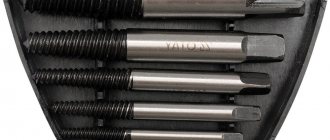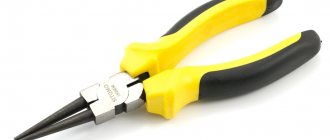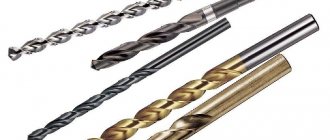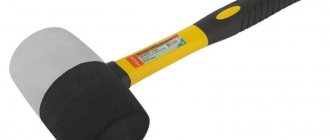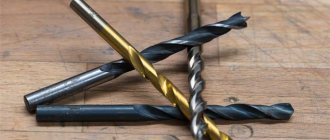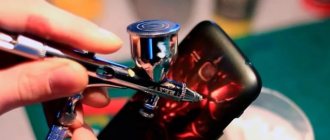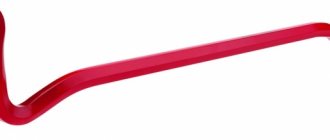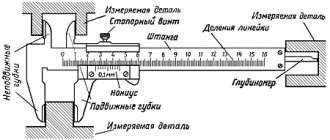Purpose and principle of operation of the extractor
Sometimes it happens that the screw fastening is damaged for various reasons, and without special tools it is not possible to unscrew the fastener.
The fastening rod itself may break or its head may fall off; also, the edges of the head slot are often licked off, so that there is nothing to catch on; in such cases, specially designed extractors are used to dismantle the screw fasteners.
This tool is indispensable for removing broken bolts from the landing site, for example, car mechanics use it to unscrew studs from the cylinder block, fasteners from the cylinder head, from the camshaft bed, from the exhaust manifold, to unscrew damaged or stuck wheel bolts from the hub and others similar cases.
Extractors can also be used to remove self-tapping screws, screws and dowel nails when the slots of their heads are licked.
With the help of small-sized extractors, it is very convenient to disassemble folding knives and other structural devices that use screw fastenings.
The screw connection can be damaged in the most unexpected situation, and then the broken fastener can be quickly and effortlessly removed without damaging the seat only using an extractor.
Each type of this tool has its own specific operating principle, which will be most suitable and effective in certain cases.
Operating principle of a wedge extractor
You need to drill a small hole of sufficient depth in the center of the broken bolt or stud, and then drive a screwdriver wedge into it.
Due to the corners of the tool, a tight engagement occurs, thanks to which it becomes possible to unscrew the broken fastener rod.
Next, using regular open-end wrenches or special tap holders, grab the shank of the screwdriver and unscrew the damaged hardware.
Operating principle of internal thread extractor
Partially similar to the previous version.
Here, too, in the center of the rod of the broken fastener, a hole is drilled into which a screwdriver is screwed, usually with a left-hand thread; accordingly, we turn the tool counterclockwise.
Due to the fact that the unscrew thread is cone-shaped, it fits tightly into the drilled hole and jams in it.
Important!
To prevent idle scrolling, it is necessary to apply sufficient force to press the tool tightly against the hardware being removed for reliable adhesion.
Thus, the extractor firmly engages with the body of the broken fastener, and with further turns it unscrews along its thread.
Such a screw extractor can be useful in the most unpredictable situations where screw fastenings are used.
Operating principle of external extractors
It differs in that it is used only in cases where the damaged fastener is of sufficient diameter and protrudes from the base.
Most often, external screwdrivers are used when there is a bolt head, but its edges are licked and there is nothing to grab onto with a regular wrench.
The process of fixing a bolt with licked head edges takes place from the outside; for this purpose, an extractor of the required size is selected and hammered onto the bolt head.
There are sharp edges inside the outer extractor that dig into the material of the licked bolt head.
Thus, engagement occurs, after which the damaged fastener is turned out.
External extractors are mainly used for unscrewing bolts whose heads have licked off edges and in similar situations.
You can also use an external extractor to unscrew nuts with damaged edges, but only if it is possible to attach a screwdriver to the nut.
Important!
To work with extractors, it is advisable to use a special wrench or a regular open-end wrench, but not pliers.
Useful tips
The work is nothing unusual for an experienced craftsman with experience working with metal. But for beginners it will be useful to know how to make this work more productive.
For example, if an extractor for unscrewing broken bolts does not hold the broken part and breaks off under significant force, then after installing it, liquid is dripped into the thread gap of the damaged bolt, making it easier to remove. If there is none, you can use machine oil, kerosene, or solvent. Leave the part for 10-15 minutes and it will probably come out.
Large diameter bolts are removed using large extractors. It is necessary to make a hole with a suitable drill. A labor-intensive and time-consuming operation. Using one drill in this case is not reasonable. The work will go much faster if you first make a hole with a diameter of less than 5 mm. And only then repeat the procedure with the required drill size.
Device and characteristics
Mechanical extractors can be internal, in terms of design: one-sided or double-sided, and external, in the sense of external.
All internal extractors are oblong in shape, with one or two working ends.
Single-sided screwdrivers have one working area in the form of a wedge or with a cone-shaped thread, left or right, with a short pitch, and on the other side there is a shank, which can be square or hexagonal.
There are also single-sided extractors, on the back of which there may be a head with a square or hexagonal throat.
For double-sided extractors, both ends are working, one of them is a short drill designed for drilling a hole of the required diameter, the other has a left-hand thread in the form of a cone, when there is a narrowing from the base of the tool body to its end.
Double-sided extractors are usually small in size, and are very similar to screwdriver bits.
Some kits come with external extractor guides designed for precise alignment so as not to accidentally drill into the main body of the object into which a bolt, stud or other fastener is screwed.
External extractors are very similar in appearance to impact sockets for impact wrenches, but they are not the same thing.
Inside the external extractors there are sharp edges in the form of smooth curls, which are absent in the socket impact heads, this is the main difference.
NOTE:
Sometimes impact sockets for impact wrenches are used as extractors, but with such treatment they quickly become unusable.
Material
Extractors are a very specific tool, intended for use only in certain emergency cases, where the hardness and strength of the material plays a very important role.
For the manufacture of extractors, carbide metals, carbon, high-speed steel are used, as a rule, these are types of hardened metal.
S2 tool steel, high-strength chrome vanadium steel CrMo, oxidized steel and other alloys with similar properties are often used.
To produce high-quality extractors, hardened steel with high hardness is always used.
Attention!
Clandestine manufacturers use softer metals in their production, which are initially unsuitable for the manufacture of such tools.
Therefore, when purchasing extractors, you need to pay attention to the manufacturer, labeling and brand under which the tool is sold.
Dimensions and weight
The weight of the tool depends on the metal used in its manufacture, as well as on its type and size.
Dimensions of internal extractors:
Length: from 26mm to 150mm.
Diameters of the conical tip: from 1.5 mm to 26 mm.
Weight: from 8 to 150 g.
For example, examples for screwdrivers, as a rule, are smaller in size and the weight of such a tool is also light.
Dimensions of external extractors:
Length: from 40mm to 80mm.
Working diameter: from 16mm to 26mm.
Weight: approximately 100-150g.
The dimensions of the external extractors correspond to the dimensions of the impact sockets (in inches):
- ¼
- 3/8
- ½
- ¾
- 1 inch
Effective ways to unscrew broken fasteners
Now let's look at how to drill out a broken bolt without special rods. A broken pin or bolt can be unscrewed without the help of extractors, but it all depends on the situation. If the breakage has already occurred at the exit from the thread, and part of the body of the fastener protrudes above the surface, then you can try to tighten it with pliers, a wrench or other tools.
There are several effective ways to remove a broken part. First you need to complete several preparatory steps:
- clean the work surface from debris and dirt;
- treat the threads with machine oil or anti-rust agent. You can relieve internal stress by hitting the piece with a hammer or heating it with a soldering iron, if possible.
If a break has formed above the threaded surface, then it makes sense to try two extraction methods:
- Pliers and an adjustable wrench will help remove the body of the bolt, provided that the threads are loose and movable.
- A grinder and a metal saw are used to form a transverse cut at the end of the hardware. A screwdriver is inserted into this hole and the element is unscrewed.
- The third method is the most labor-intensive, but just as effective. You will need a welding machine. A bolt with a head of approximately the same diameter is selected for the broken part. It is welded to the fragment by welding and the old fasteners are unscrewed without any extra effort.
The situation is more complicated with breakdown below the surface. To unscrew the fastener with a screwdriver, you will need a drill with a thin drill bit. Several holes are drilled, gradually combining them into a continuous transverse cut. They insert a screwdriver into it and try to remove the stuck fragment.
If the bolt breaks flush with the surface, you can try to drill it out. The method is complex and dangerous, since there is a high probability of damaging the thread.
Extractors for unscrewing broken studs and bolts are the most convenient, safe and effective method for removing broken fastener fragments. Tools are sold both in sets and in single copies. It is more profitable to purchase kits because they are universal and are used in different situations. The sets are durable and reliable, as they are made from chrome vanadium steel.
Previous entry Foundation bolts Next entry Advantages and characteristics of anti-vandal bolts
GOST
GOST for metalwork extractors intended for turning out broken bolts and other screw connections has not been developed.
Each manufacturer produces this tool in accordance with its specifications.
Well-known brands have their own laboratories where they develop the most optimal composition of materials from which they produce high-quality professional tools.
Marking
Marking of extractors may either be completely absent or indicate the range of diameters for which a particular specimen is suitable; sometimes the brand under which the tool is manufactured is marked and its hardness is indicated.
Some manufacturers indicate in the marking what material the part is made from, for example: HrMo, CrV, S2 and others.
On double-sided extractors, the order of use of each side is sometimes indicated, so the letter “A” marks the side with a drill, the letter “B” marks the side with screw slots.
Different manufacturers have their own markings, where the number indicates a specific size, for example:
No. 1.: L 47.82 mm, d 3.16 mm;
No. 2.: L 59.14 mm, d 4.75 mm;
No. 3.: L 66.24 mm, d 6.18 mm;
No. 4.: L 75.59 mm, d 8.62 mm;
No. 5.: L 81.2 mm, d 10.98 mm.
Where: L – length; D – diameter;
HRC symbols - show the hardness of the metal from which the tool is made, for example: 36-40 HRC or 60-62 HRC, the higher the number, the higher the hardness of the material.
Types of extractors
A bench extractor is a hand-held mechanical tool that comes in many varieties, all designed to remove broken bolts and other similar fasteners.
This plumbing tool is distinguished by the type of device, which can be single-sided or double-sided, as well as by its principle of operation, form and purpose.
Based on the method of use, there are two types of extractors: internal and external, or external.
External extractor (external)
As mentioned above, the external extractor, also known as the extractor head, is very similar in shape and appearance to a socket impact head for impact wrenches.
Inside this tool there is a special protruding sharp profile, thanks to which it catches on the broken rod of a threaded connection or on the head of a bolt with licked edges.
Such a screwdriver is pushed onto the removable fastener from above so that its edges cut into the base of the broken screw connection, after which it is unscrewed using a regular wrench or wrench.
Internal extractor
The name defines how the tool is used; in this case, it does its work inside the damaged screw fastener.
An internal driver is designed to drive or screw into the body of a broken bolt or into its head, so that engagement occurs, allowing it to be turned.
After engagement, the rotational energy is transferred to the broken bolt and, thus, it is unscrewed.
Thread extractor
This is the most common type of extractor, which refers to internal specimens; due to the shape of the main working area, it is also called a conical extractor.
At the main working end of such screwdrivers there is a left-hand thread with a fine pitch, thanks to which it is screwed into the damaged hardware until it jams.
First, a hole is drilled in the center of the damaged fastener, along its axis, to screw a conical extractor into it counterclockwise.
Next, the screw fastener is unscrewed.
To remove screw hardware with left-hand threads, extractors with right-hand notches are produced.
Hairpin extractor or thread extractor
This is the same tool as the previous option only with a different name, we mentioned it here
Internal extractors are available in single-sided and double-sided types.
Single-sided extractor
A tool that has only one working side, which can be made in the form of a wedge or in the form of a cone drill.
In this case, the wedge can have a double cutting edge, which increases the grip points and makes it easier to turn out the bolts.
The back side of such specimens has a tetrahedral or hexagonal shank.
Double-sided extractor
From the name it is clear that such a tool has two working ends, one of which, as a rule, has the shape of a conical spiral with a left-hand thread, and the other is a short drill for drilling a hole.
The main body of double-sided screwdrivers, as a rule, is small in size and made in the shape of a hexagon, in this they are very similar to bits for screwdrivers.
This instrument also varies in shape.
Wedge extractor
Most often this is a tetrahedral or flat extractor, which has a wedge-shaped working area.
It is driven into the center of the broken threaded connection into a hole pre-drilled in it, where the tool jams, as a result of which it becomes possible to unscrew the broken fastener.
The advantage of such twists is that you can unscrew a broken bolt in any direction, even to the right or to the left.
In addition, the production technology of this tool is much simpler and, as a result, it is noticeably cheaper than its counterparts.
The main disadvantage of wedge-shaped extractors is that they require sufficient space to drive in, requiring room to swing the hammer.
Rod extractor
This tool looks like a cylindrical rod along which there are longitudinal cutting edges and grooves between them.
This rod is driven into the center of the broken bolt or other screw connection, without pre-drilling, the sharp edges of the extractor cut into the hardware being removed, thereby causing engagement.
Then a special attachment with a tetrahedral shank is installed on the other edge of the tool, which is grasped with a wrench or wrench and the stuck fasteners are unscrewed.
The inconvenience of a rod extractor is that it gets very stuck in the bolt or stud being removed, and in order to pull it out you need to hit it with a hammer from different sides.
Combined extractor
This type of tool is a combination of the two previous ones: wedge-shaped and rod.
The shape of such an extractor is wedge-shaped, and for more reliable adhesion it has a larger number of sharp edges that engage the body of the hardware being extracted.
The engagement process occurs by driving the extractor into the center of the broken bolt or stud.
When the screwdriver is driven in to a sufficient depth so that engagement occurs, they can be unscrewed both to the left and to the right, depending on the thread of the fastener.
Extractor-drill
The working end of such a screwdriver is similar to a left-handed drill, its edges are made in the form of cutting edges, so that this tool is able to independently cut into the body of a damaged screw fastener, even without pre-drilling.
During the screwing process, jamming occurs, due to which the damaged fastener is turned out.
Screw spiral extractor
This type of tool is made in the form of a conical twist drill, which is screwed into the center of the bolt or stud being removed into the hole drilled for it.
Screw twisters come with a right-handed and left-handed spiral, respectively, for unscrewing fasteners with opposite threads.
Spirals can have more than one entry, which increases the jamming force in the extracted hardware.
The Screw Extractor, like the threaded one, is a multifunctional tool; with their help you can unscrew almost any screw hardware, both with and without a head, which is why they are more popular.
After removing the stuck hardware, unscrew the extractor in the opposite direction.
Eccentric extractor
An eccentric extractor is a stud driver with an offset center, which is originally designed for turning out studs.
This tool is designed in such a way that it can be used to unscrew a screw fastener with a head whose edges are erased or without a head at all.
That is why an eccentric pin driver is considered one of the varieties of specialized screwdrivers.
This type of extractor has one limitation - it can only help unscrew stuck hardware if there is something to grab onto.
In other words, for unscrewing broken bolts whose body remains in the base and does not protrude from it or protrudes but not significantly, an eccentric extractor will not help.
Extractor for screwdriver
This type of tool includes small-sized screwdrivers, which are a type of bits for screwdrivers; they can be double-sided or single-sided.
A distinctive feature of extractors for screwdrivers is that their main body is made in the form of a hexagonal rod.
Depending on the situation, they can be used as a separate hand tool or as attachments for a screwdriver.
As a rule, such screwdrivers are sold in sets, which also include special drivers, drills and guide bushings designed for centering the hole being drilled.
All extractors are designed to remove damaged screw connections, but some have their own specialization.
Secret extractor
This is the same external extractor that is used to remove security bolts from car wheels.
Only the name differs, and in some cases the wall thickness may be thinner so that the extractor head fits freely on the wheel bolt head without damaging the alloy wheels.
Reinforced extractor
This type of extractor differs only in the material from which this tool is made.
Thanks to various additives, the strength of such a screwdriver noticeably increases, which ensures greater reliability and service life.
Pipe extractor
This type of screwdriver is designed for turning out pieces of water pipes, gas pipelines, and various pipeline adapters in cases where it is impossible to turn them out with a conventional tool.
Such a tool is completely similar to screw extractors, and it works on the same principles, but is larger in size.
The only difference is that there is no need to drill a hole in the pipe, because... it is initially there, this is where the pipe extractor is screwed in, where the jamming occurs, after which the pipe is unscrewed.
One of the types of pipe extractors is an eccentric device, which, thanks to its mechanism, jams in the pipe and allows it to be unscrewed.
This tool is universal and fits pipes with a diameter of 1/2″ (12.7 mm) and 3/4″ (19 mm).
Universal extractor
This tool is designed to turn out the remains of a pipe or some part of the pipeline that cannot be caught in other ways.
It is called universal because it can be used for different pipe diameters within the dimensions of the tool itself.
This screwdriver works on the principle of an internal threaded extractor; if necessary, this device can be used in other cases.
Hydraulic Pipe Extractor
A specialized professional tool designed for turning out rolled pipes.
This is a large manual hydraulic unit that is used only in industrial production.
Benefits of using the tool
Compared to traditional methods, the device has a significant advantage. Once installed, the fixture practically becomes part of the broken part, but with higher strength. The tool was developed by professionals. Then serious tests were carried out. The optimal shape of the product, pitch of notches, sharpness and number of edges were calculated.
It is impossible to achieve a similar result with improvised means. Only an extractor for unscrewing broken bolts has unique characteristics for holding a broken part. The advantages include minimal time for the procedure. With skill and ordinary auxiliary tools, you can remove the fragment in a minute.
What you need to know about extractors?
The edges of extractors made of soft metals quickly lick off, and such a tool becomes unsuitable for work almost from the first minutes.
Soft metals are most often used in the manufacture of tools by Chinese gray manufacturers, which makes the price of their products even lower.
You shouldn’t chase cheapness; it’s better to buy a professional tool made from quality materials once, which will serve for a long time.
Important!
Chinese instruments can also be of high quality and professional, it all depends on the manufacturer.
Fake extractors with false labeling are often found even in specialized stores; to avoid being deceived, ask the seller for certificates of conformity.
It is more profitable to buy sets of extractors, the kit of which includes several different tool sizes; sometimes there is also a wrench or a special attachment for a tetrahedron or hexagon.
There are also kits that come with a guide sleeve, which makes it much easier and simpler to drill a hole in the stuck hardware strictly in the center.
In addition, the extractor sets are placed in special cases or cases; storing and transporting the tool in such boxes is much more convenient.
How to prevent edges from being torn off
To prevent such a problem as torn edges of a bolt or splines of a screw or screw from taking you by surprise, you must adhere to simple rules:
- You need to buy only high-quality fasteners that have high strength and reliability;
- When tightening and unscrewing screws or screws, do not allow the screwdriver to slip through the slots. This leads to their abrasion and it will be difficult to unscrew such fasteners;
- You should always monitor the condition of the instrument. If a screwdriver or key has licked edges, then it will be difficult to unscrew a screw, bolt or screw with their help.
It is much easier to prevent the edges of bolts, screws and screws from licking off than to then unscrew damaged fasteners.
Do not panic if a problem appears such as a licked bolt head or slots on the head of a screw or screw. There are many ways to solve it. It is necessary to adequately assess the situation and choose one of the available options.
